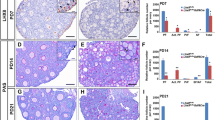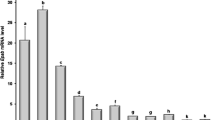Abstract
Purpose
The age-associated decline in female fertility is largely ascribable to the decrease in oocyte quality. The subcortical maternal complex (SCMC) is a multiprotein complex essential for early embryogenesis and female fertility and functionally conserved across mammals. The present work evaluated expression dynamics of its components during folliculogenesis in relation to maternal age in sheep.
Methods
The expression of the SCMC components (KHDC3/FILIA, NLRP2, NLRP5/MATER, OOEP/FLOPED, PADI6, TLE6 and ZBED3) was analyzed by real-time PCR in pools of growing oocytes (GO) of different diameters (70–90 μm (S), 90–110 μm (M), or 110–130 μm (L)) derived from non-hormonally treated adult (Ad; age < 4 years), prepubertal (Pr; age 40 days), or aged ewes (age > 6 years).
Results
Specific expression patterns associated with donor age were observed during folliculogenesis for all genes, except ZBED3. In oocytes of adult donors, the synthesis of NLRP2, NLRP5, PADI6, and ZBED3 mRNAs was complete in S GO, while FILIA, TLE6, and OOEP were actively transcribed at this stage. Conversely, Pr GO showed active transcription of all mRNAs, except for ZBED3, during the entire window of oocyte growth. Notably, aged GO showed a completely inverse pattern, with a decrease of NLRP2, TLE6, FILIA, and PADI6 mRNA abundance during the latest stage of oocyte growth (L GO). Interestingly, MATER showed high expression variability, suggesting large inter-oocyte differences.
Conclusion
Our study describes the SCMC expression dynamics during sheep oogenesis and reports age-specific patterns that are likely involved in the age-related decline of oocyte quality.







Similar content being viewed by others
References
Li L, Baibakov B, Dean J. A subcortical maternal complex essential for preimplantation mouse embryogenesis. Dev Cell. 2008;15:416–25.
Zhu K, Yan L, Zhang X, Lu X, Wang T, Yan J, et al. Identification of a human subcortical maternal complex. Mol Hum Reprod. 2015;21:320–9.
Ohsugi M, Zheng P, Baibakov B, Li L, Dean J. Maternally derived FILIAMATER complex localizes asymmetrically in cleavage-stage mouse embryos. Development. 2008;135:259–69.
Zheng P, Dean J. Oocyte-specific genes affect folliculogenesis, fertilization, and early development. Semin Reprod Med. 2007;25:243–51.
Ledda S, Bebbere D, Ariu F, Pescatori M, Pau S, Zedda MT, et al. Unveiling mRNA changes during meiotic progression and pre-implantation development: help from large animal models. Curr Pharm Des. 2012;18:256–63.
Dean J. Oocyte-specific genes regulate follicle formation, fertility and early mouse development. J Reprod Immunol. 2002;53:171–80.
Zhang K, Smith GW. Maternal control of early embryogenesis in mammals. Reprod Fertil Dev. 2015;27:880–96.
Bebbere D, Ariu F, Bogliolo L, Masala L, Murrone O, Fattorini M, et al. Expression of maternally derived KHDC3, NLRP5, OOEP and TLE6 is associated with oocyte developmental competence in the ovine species. BMC Dev Biol. 2014;14:40.
Bebbere D, Masala L, Albertini DF, Ledda S. The subcortical maternal complex: multiple functions for one biological structure? J Assist Reprod Genet. 2016;33:1431–8.
Yu XJ, Yi Z, Gao Z, Qin D, Zhai Y, Chen X, et al. The subcortical maternal complex controls symmetric division of mouse zygotes by regulating F-actin dynamics. Nat Commun. 2014;5:4887.
Lu X, Gao Z, Qin D, Li L. A maternal functional module in the mammalian oocyte-to-embryo transition. Trends Mol Med. 2017;23:1014–23.
Mahadevan S, Sathappan V, Utama B, Lorenzo I, Kaskar K, Van den Veyver IB. Maternally expressed NLRP2 links the subcortical maternal complex (SCMC) to fertility, embryogenesis and epigenetic reprogramming. Sci Rep. 2017;7:44667.
Tong ZB, Gold L, Pfeifer KE, Dorward H, Lee E, Bondy CA, et al. Mater, A maternal effect gene required for early embryonic development in mice. Nat Genet. 2000;26:267–8.
Tashiro F, Kanai-Azuma M, Miyazaki S, Kato M, Tanaka T, Toyoda S, et al. Maternal-effect gene Ces5/Ooep/Moep19/Floped is essential for oocyte cytoplasmic lattice formation and embryonic development at the maternal-zygotic stage transition. Genes Cells. 2010;15:813–28.
Zheng P, Dean J. Role of Filia, A maternal effect gene, in maintaining euploidy during cleavage-stage mouse embryogenesis. Proc Natl Acad Sci U S A. 2009;106:7473–8.
Gao Z, Zhang X, Yu X, Qin D, Xiao Y, Yu Y, et al. Yi Z3, Li L. Zbed3 participates in the subcortical maternal complex and regulates the distribution of organelles. J Mol Cell Biol. 2018;10:74–88.
Xu Y, Shi Y, Fu J, Yu M, Feng R, Sang Q, et al. Mutations in PADI6 cause female infertility characterized by early embryonic arrest. Am J Hum Genet. 2016;99:744–52.
Wang X, Song D, Mykytenko D, Kuang Y, Lv Q, Li B, et al. Novel mutations in genes encoding subcortical maternal complex proteins may cause human embryonic developmental arrest. Reprod BioMed Online. 2018;36:698–704.
Lin J, Xu H, Chen B, Wang W, Wang L, Sun X, et al. Expanding the genetic and phenotypic spectrum of female infertility caused by TLE6 mutations. J Assist Reprod Genet. 2020;37:437–42.
Zheng W, Chen L, Dai J, Dai C, Guo J, Lu C, et al. New biallelic mutations in PADI6 cause recurrent preimplantation embryonic arrest characterized by direct cleavage. J Assist Reprod Genet. 2020;37:205–12.
Krisher RL. Maternal age affects oocyte developmental potential at both ends of the age spectrum. Reprod Fertil Dev. 2018;31:1–9.
Cimadomo D, Fabozzi G, Vaiarelli A, Ubaldi N, Ubaldi FM, Rienzi L. Impact of maternal age on oocyte and embryo competence. Front Endocrinol (Lausanne). 2018;9:327.
Ledda S, Bebbere D. Oocyte quality during reproductive ageing: are the chromosomal abnormalities the only problem? Hum Reprod. 2019;34(1):i23.
Hamatani T, Falco G, Carter MG, Akutsu H, Stagg CA, Sharov AA, et al. Age-associated alteration of gene expression patterns in mouse oocytes. Hum Mol Genet. 2004;13:2263–78.
Lu YQ, He XC, Zheng P. Decrease in expression of maternal effect gene Mater is associated with maternal ageing in mice. Mol Hum Reprod. 2016;22:252–60.
Bustin SA, Benes V, Garson JA, Hellemans J, Huggett J, Kubista M, et al. The MIQE guidelines: minimum information for publication of quantitative real-time PCR experiments. Clin Chem. 2009;55:611–22.
Taylor SC, Nadeau K, Abbasi M, Lachance C, Nguyen M, Fenrich J. The ultimate qPCR experiment: producing publication quality, reproducible data the first time. Trends Biotechnol. 2019;37:761–74.
Evsikov AV, Marín de Evsikova C. Gene expression during the oocyte-to embryo transition in mammals. Mol Reprod Dev. 2009;76:805–18.
Su YQ, Sugiura K, Woo Y, Wigglesworth K, Kamdar S, Affourtit J, et al. Selective degradation of transcripts during meiotic maturation of mouse oocytes. Dev Biol. 2007;302:104–17.
McDaniel P, Wu X. Identification of oocyte-selective NLRP genes in rhesus macaque monkeys (Macaca mulatta). Mol Reprod Dev. 2009;76:151–9.
Kuchmiy AA, D’Hont J, Hochepied T, Lamkanfi M. NLRP2 controls age-associated maternal fertility. J Exp Med. 2016;213:2851–60.
Chavanas S, Méchin MC, Takahara H, Kawada A, Nachat R, Serre G, et al. Comparative analysis of the mouse and human peptidylarginine deiminase gene clusters reveals highly conserved non-coding segments and a new human gene, PADI6. Gene. 2004;330:19–27.
Fagerberg L, Hallström BM, Oksvold P, Kampf C, Djureinovic D, Odeberg J, et al. Analysis of the human tissue-specific expression by genome-wide integration of transcriptomics and antibody-based proteomics. Mol Cell Proteomics. 2014;13:397–406.
Pierre A, Gautier M, Callebaut I, Bontoux M, Jeanpierre E, Pontarotti P, et al. Atypical structure and phylogenomic evolution of the new eutherian oocyte- and embryo-expressed KHDC1/DPPA5/ECAT1/OOEP gene family. Genomics. 2007;90:583–94.
Khatir H, Lonergan P, Carolan C, Mermillod P. Prepubertal bovine oocyte: a negative model for studying oocyte developmental competence. Mol Reprod Dev. 1996;45:231–9.
Nicholas FW. Genetic improvement through reproductive technology. Anim Reprod Sci. 1996;42:205–14.
Morton KM. Developmental capabilities of embryos produced in vitro from prepubertal lamb oocytes. Reprod Domest Anim. 2008;43:137–43.
Armstrong DT, Holm P, Irvine B, Petersen BA, Stubbings RB, McLean D, et al. Pregnancies and live birth from in vitro fertilization of calf oocytes collected by laparoscopic follicular aspiration. Theriogenology. 1992;38:667–78.
Armstrong DT, Kotaras PJ, Earl CR. Advances in production of embryos in vitro from juvenile and prepubertal oocytes from the calf and lamb. Reprod Fertil Dev. 1997;9:333–9.
Ledda S, Bogliolo L, Leoni G, Naitana S. Production and lambing rate of blastocysts derived from in vitro matured oocytes after gonadotropin treatment of prepubertal ewes. J Anim Sci. 1999;77:2234–9.
Revel F, Mermillod P, Peynot N, Renard JP, Heyman Y. Low developmental capacity of in vitro matured and fertilized oocytes from calves compared with that of cows. J Reprod Fertil. 1995;103:115–20.
Leoni GG, Succu S, Berlinguer F, Rosati I, Bebbere D, Bogliolo L, et al. Delay on the in vitro kinetic development of prepubertal ovine embryos. Anim Reprod Sci. 2006;92:373–83.
Leoni GG, Bebbere D, Succu S, Berlinguer F, Mossa F, Galioto M, et al. Relations between relative mRNA abundance and developmental competence of ovine oocytes. Mol Reprod Dev. 2007;74:249–57.
Masala L, Burrai GP, Bellu E, Ariu F, Bogliolo L, Ledda S, et al. Methylation dynamics during folliculogenesis and early embryo development in sheep. Reproduction. 2017;153:605–19.
Masala L, Ariu F, Bogliolo L, Bellu E, Ledda S, Bebbere D. Delay in maternal transcript degradation in ovine embryos derived from low competence oocytes. Mol Reprod Dev. 2018;85:427–39.
Leoni GG, Palmerini MG, Satta V, Succu S, Pasciu V, Zinellu A, et al. Differences in the kinetic of the first meiotic division and in active mitochondrial distribution between prepubertal and adult oocytes mirror differences in their developmental competence in a sheep model. PLoS One. 2015;10:e0124911.
Svoboda P, Franke V, Schultz RM. Sculpting the transcriptome during the oocyte-to-embryo transition in mouse. Curr Top Dev Biol. 2015;113:305–49.
Jiao ZX, Woodruff TK. Follicle microenvironment-associated alterations in gene expression in the mouse oocyte and its polar body. Fertil Steril. 2013;99:1453–9.
Esposito G, Vitale AM, Leijten FP, Strik AM, Koonen-Reemst AM, Yurttas P, et al. Peptidylarginine deiminase (PAD) 6 is essential for oocyte cytoskeletal sheet formation and female fertility. Mol Cell Endocrinol. 2007;273:25–31.
Chiang T, Duncan FE, Schindler K, Schultz RM, Lampson MA. Evidence that weakened centromere cohesion is a leading cause of age-related aneuploidy in oocytes. Curr Biol. 2010;20(17):1522–8.
Lister LM, Kouznetsova A, Hyslop LA, Kalleas D, Pace SL, Barel JC, et al. Age-related meiotic segregation errors in mammalian oocytes are preceded by depletion of cohesin and Sgo2. Curr Biol. 2010;20:1511–21.
Gruhn JR, Zielinska AP, Shukla V, Blanshard R, Capalbo A, Cimadomo D, et al. Chromosome errors in human eggs shape natural fertility over reproductive life span. Science. 2019;365:1466–9.
Seidler EA, Moley KH. Metabolic determinants of mitochondrial function in oocytes. Semin Reprod Med. 2015;33:396–400.
Bogliolo L, Ariu F, Leoni G, Uccheddu S, Bebbere D. High hydrostatic pressure treatment improves the quality of in vitro-produced ovine blastocysts. Reprod Fertil Dev. 2011;23:809–17.
Docherty LE, Rezwan FI, Poole RL, Turner CL, Kivuva E, Maher ER, et al. Mutations in NLRP5 are associated with reproductive wastage and multilocus imprinting disorders in humans. Nat Commun. 2015;6:8086.
Akoury E, Zhang L, Ao A, Slim R. NLRP7andKHDC3L, The two maternal effect proteins responsible for recurrent hydatidiform moles, co-localize to the oocyte cytoskeleton. Hum Reprod. 2015;30:159–69.
Demond H, Anvar Z, Jahromi BN, Sparago A, Verma A, Davari M, et al. A KHDC3L mutation resulting in recurrent hydatidiform mole causes genome-wide DNA methylation loss in oocytes and persistent imprinting defects post-fertilisation. Genome Med. 2019;11:84.
Ivanova E, Canovas S, Garcia-Martínez S, Romar R, Lopes JS, Rizos D, et al. DNA methylation changes during preimplantation development reveal inter-species differences and reprogramming events at imprinted genes. Clin Epigenetics. 2020;12:64.
Zhu P, Guo H, Ren Y, Hou Y, Dong J, Li R, et al. Single-cell DNA methylome sequencing of human preimplantation embryos. Nat Genet. 2018;50:12–9.
Kobayashi H, Sakurai T, Imai M, Takahashi N, Fukuda A, Yayoi O, et al. Contribution of intragenic DNA methylation in mouse gametic DNA methylomes to establish oocyte-specific heritable marks. PLoS Genet. 2012;8(1):e1002440.
Author information
Authors and Affiliations
Corresponding author
Additional information
Publisher’s note
Springer Nature remains neutral with regard to jurisdictional claims in published maps and institutional affiliations.
Rights and permissions
About this article
Cite this article
Bebbere, D., Abazari-Kia, A., Nieddu, S. et al. Subcortical maternal complex (SCMC) expression during folliculogenesis is affected by oocyte donor age in sheep. J Assist Reprod Genet 37, 2259–2271 (2020). https://doi.org/10.1007/s10815-020-01871-x
Received:
Accepted:
Published:
Issue Date:
DOI: https://doi.org/10.1007/s10815-020-01871-x




